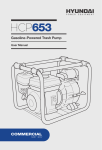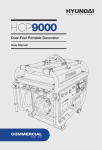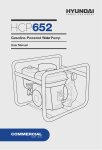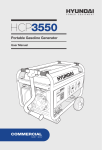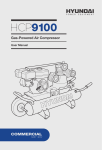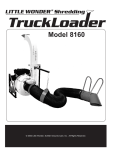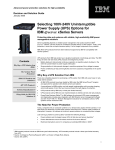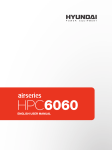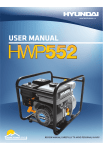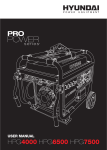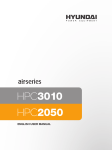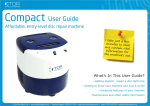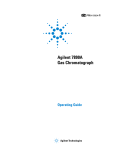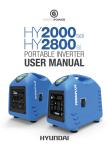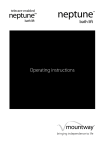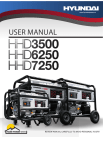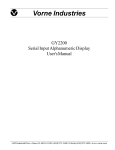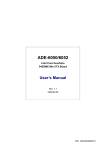Download Gas-Powered Pressure Washer
Transcript
Gas-Powered Pressure Washer User Manual 1 ©2011 Hyundai Power Equipment. All Rights Reserved. Licensed by Hyundai Corporation, Korea. hcp3000-0711-02 2 3 4 Thank you for purchasing this Hyundai Power Equipment Pressure Washer. Please register this product in order to ensure warranty service in the future. This manual covers the safety, operation and maintenance procedures for the HCP3000. All information in this publication is based on the latest product information available at the time of print. Visit www.powerbyhyundai.com for manual updates and operation notices. No part of this publication may be reproduced without written permission. Please keep this manual together with the Owners Card. Contact Hyundai Power Equipment at the numbers listed on the Owners Card if warranty service is required. It is important that anyone operating this product read and understand the manual prior to use. 5 Warranty Information Warranty service, operation assistance and product support is provided by Midland International Inc., a licensed manufacturer of Hyundai Power Equipment. www.powerbyhyundai.com TECHNICAL ASSISTANCE 1-855-706-8475 CUSTOMER SERVICE 1-877-528-3772 (toll-free) SALES 1-503-534-3684 Component Certifications This product contains components certified by the following agency: 6 TABLE OF CONTENTS 1.0 - OPERATION SAFETY 1.1 - Operation Safety 8 1.2 - Water Safety Guidelines 9 1.3 - Maintenance Safety 9 2.0 - COMPONENTS 2.1 - Identification 11 2.2 - Assembly 12 3.0 - PRE-OPERATION INSPECTION 3.1 - Engine Oil Check 16 3.2 - Pump Oil Check 17 3.3 - Fuel Level Check 17 3.4 - Air Filter Check 18 4.0 - OPERATION 4.1 - Connecting Water Source 19 4.2 - Starting the Pressure Washer 19 4.3 - Stopping the Engine 20 4.4 - Using the Pressure Washer 21 4.5 - Using QuickNozzles 22 4.6 - Using Detergents 22 5.0 - MAINTENANCE 5.1 - Importance of Maintenance 23 5.2 - Maintenance Schedule 23 5.3 - General Inspection 24 5.4 - Air Filter Service 24 5.5 - Oil Maintenance 25 5.6 - Spark Plug Service 26 5.7 - Fuel Sediment Cup 27 5.8 - Handling and Storage 28 6.0 - TROUBLESHOOTING 29 7.0 - SPECIFICATIONS 30 WARRANTY 37 7 1.0 - SAFETY 1.1 - Operation Safety • Always perform a pre-operation check before starting the engine. • Properly clean and maintain the equipment. • Operate the Pressure Washer according to instructions for safe and dependable service. • Read user manual carefully before operating this product! Failure to do so may result in serious harm to the user and to the equipment. • This product emits poisonous carbon monoxode gas. Do not operate in an enclosed area. • Be careful not to touch the exhaust system, water pump during operation due to risk of burns. • Pay attention to the warning labels. The engine exhaust system will become heated during operation and remains hot immediately after the engine is stopped. • Gasoline is a highly flammable and explosive liquid. Refuel in a well ventilated area with the engine stopped. • When refueling the Pressure Washer, keep it away from cigarettes, open flames, smoke and/or sparks. • Place at least 5ft away from buildings or other equipment during operation. • Run on a level surface to avoid fuel spills • Know how to stop the engine quickly and understand operation of all the controls. Never permit anyone to operate this tool without proper training. • Keep children, pets and machinery with rotating parts away during operation. • Do not touch the spark plug while the engine is operating or shortly after the engine has been shut down. 8 1.2 - Water Safety Guidelines • Keep all protective components in place - do not remove guards or shields from any part of the engine • Use caution near the engine - do not soak or expose the casing to a constant flow of water • Do not operate while wearing open-toed shoes • Do not over-extend while using the spray wand - use caution when standing on ladders • Do not direct the water stream at persons or pets - water sprays at a very high pressure and can result in skin damage • Wear appropriate eye protection - gloves are also recommended • Do not aim the water stream directly at delicate surfaces - if unsure of stream effect, spray indirectly and at a distance. • Do not direct spray at or near engine components. • Do not shift focus while water stream is on - keep attention on where the stream is aimed and ensure that water flow stops before looking away. 1.3 - Maintenance Safety • After any maintenance is performed, wash hands immediately using soap and clean water. Repeated exposure to lubricant may cause skin irritation. • Do not clean the filter element with flammable liquids like gasoline because explosion may occur. • Turn off the engine set before performing any maintenance, otherwise it can cause severe personal injury or death. • Allow the engine to cool down before performing any maintenance. • Always wear safety glasses when cleaning the engine with air. • Use rubber gloves when coming into contact with engine oil. • Always stop the engine before removing the oil filler cap. • Only qualified maintenance personnel with knowledge of fuels, electricity, and machinery hazards should perform delicate maintenance procedures. 9 2.0 - COMPONENTS AND ASSEMBLY 2.1 - Identification of Components 10 11 2.2 - Assembly Before using this Pressure Washer, make sure that the detatchable components have been properly assembled. If any parts show signs of damage or are missing, do not proceed with use. Contact Hyundai Power Equipment to request a repalcement immediately. Do not attempt to assemble or connect any components while the engine is running. Do not force any attachments if you feel excess resistance. Make sure that all connections are secure before proceeding to start the engine and use the Pressure Washer. 1. Expand Handles - Twist the handle locks in the direction indicated by the arrows. Once loose, extend the telescoping assembly and tighten locks accordingly. Do not overtighten. 12 2. Assemble Gun - Insert wand extention into the opening at the end of the spray gun. Ensure that threads are properly positioned before twisting until tight. Do not overtighten wand extention. 3. Connect Hose to Spray Gun - Pull back the quick-connector and insert into the base of the spray gun. Press firmly into opening and ensure that the quick-connector clicks into place. Repeat when connecting to the Pressure Washer. Ensure that all quick-release connectors are secure - on the wand, nozzle, hoses and pump - before using the pressure washer. 13 4. Connect Water Main - Water inlet is located next to the air filter assembly. Firmly connect the water hose before turning on at the source. 5. Add Engine Oil - Open oil inlet located opposite the recoil starter handle. Remove the dipstick and pour in the supplied oil with a funnel. Do not operate without oil. `Reservoir can hold maximum 20 fl.oz of 10W30 oil - do not over fill. 14 6. Check Pump Oil (see section 3.2). If necessary, add oil - Oil inlet is located across from the output opening. Rotate screw and apply oil using a funnel. Do not operate without oil. Reservoir can hold maximum 11 fl.oz of 10W30 oil - do not over fill. 7. Fill Fuel Tank - Remove tank cap and fill tank using a funnel. Immediately wipe any excess fuel and take care not to ovefill tank. Fuel reservoir can hold a maximum of 1 gal. of regular unleaded gasoline. Do not use other types of fuel or a mixture with more than 10% ethanol. 15 3.0 Pre-Operation Inspect all components for damage and to ensure that none are missing. If you require a replacement, do not operate this equipment until all parts are present and in proper working order. Do not modify or create accessories for this equipment. Using modified components may result in damage to this equipment and may void the warranty. Contact customer service if you suspect that this equipment has been tampered with. 3.1 - Engine Oil Check 1. Ensure the Pressure Washer is on a level surface. 2. Inspect engine oil: • Take out the dipstick and clean it with a dry towel. • Check the oil level by reinserting the oil filler cap without rotating it. Remove the oil filler cap and examine the oil level. If the oil level is at or below the lower level, refill the oil to the upper limit mark. (10W30) Reinsert the oil filler cap and tighten securely. Engine oil is a major factor affecting engine performance and service life. Do not use non-detergent or vegetable oils. 16 3.2 - Pump Oil Check 1. Ensure the pressure washer is on a level surface. 2. Inspect pump oil by checking oil level indicator 3. The window should be filled past the midway point indicated by a red dot. If the oil level is below the red dot, add more oil to the pump. 3.3 - Fuel Level Check 1. Check the fuel level by opening the tank and visually inspecting 2. Refuel if level is too low. Tighten the fuel tank cap securely after refilling Gasoline is highly flammable and explosive under certain conditions. Refuel in a well-ventilated area with the engine stopped. Do not smoke or allow open 17 flames or sparks in the area where the Pressure Washer is being refueled or where gasoline is stored. Do not overfill the tank. Be careful not to spill fuel when refueling. Wipe up any spilled gasoline and let the area dry before starting the engine. Gasoline substitutes such as gasohol are not recommended. They may be harmful to the fuel system components 3.4 - Check the Air Filter 1. Loosen the knob and remove the air filter cover. Remove the air filter element and inspect for cleanliness. 2. Clean the air filter element with soap and water or solvent. Squeeze dry and then soak in clean engine oil. 3. Squeeze out all excess oil and reinstall. Replace the element if it is damaged. Check the air filter according to the maintenance schedule. Always inspect the air filter before using the Pressure Washer. Clean the air filter every 3 months or after 50hrs of operation according Section 5.4: Air Filter Service procedure. 18 4.0 - OPERATION 4.1 - Connecting the Water Source 1. Water supply should be from a regular tap or clean water tank - do not use hot water. When using a regular garden hose, allow water to flow for approximately 30 seconds to clear out debris and air pockets. 2. Turn off water source prior to uncoiling the hose and removing knots 3. Connect hose to intake port and tighten by hand 4. Connect the high pressure hose to the pump (ensure that hose is secure prior to starting engine or pump) 4.2 - Starting the Pressure Washer RECOIL START METHOD 1. Rotate the fuel valve lever to ON position. 2. If the engine is cold: Push the choke lever to the CLOSE position out to close the choke. 3. Grasp the recoil starter handle and pull it until the engine starts. 19 If recoil starter is hard to pull due to built-up pressure inside the hose, remove the nozzle and press handle trigger while pulling the recil starter. Do not allow the recoil starter to snap back. Return it slowly by hand. 4. Push the choke lever to the OPEN position as the engine warms up. The choke is used to provide the proper mixture when the engine is cold. It can be opened and closed manually by moving the choke lever to the closed position to enrich the mixture for cold starting. If the engine backfires or does not start after repeated attempts, contact customer support and do not attempt to use the pressure washer. 5. After 5 minutes, slowly push the throttle lever to the OPEN position. Engine RPMs will increase until engine reaches its stable running speed. 4.3 - Stopping the Engine 1. Return the throttle lever to the IDLE position (towards the right) 2. Turn the engine switch to the OFF position 3. Turn the fuel valve to the OFF position 4. After the engine is off, pull the trigger handle to release pressure. Failure to do so will cause difficulty when disconnecting components. In an emergency, the engine can be quickly stopped by turning the engine switch to the OFF position. If the pressure washer stops suddenly, be sure to 20 hold the trigger down until all pressure is released before starting up again. Attempting to start the engine without releasing the pressure can severely damage your pressure washer. Failure to release built-up pressure may result in startup difficulties and permanent damage to pump and other components. 4.4 - Using the Pressure Washer Wear safety goggles and pay close attention to where the spray wand is aimed. Do not look away while it is in use and ensure that there are no distractions nearby. Do not use near children, animals or delicate electrical equipment. Do not direct the wand directly at a flat surface prior to pressing the trigger handle. To prevent surface damage, keep nozzle tip a minimum of 20" away from the surface being cleaned. USING THE SPRAY GUN 1. For increased safety and control use both hands when operating the spray gun. Aim away from intended surface (at pavement or soil) prior to pressing the trigger handle. 2. Hold the wand shaft with one hand while firmly holding the handle with the other. Slowly press the trigger handle. 3. Release trigger handle to stop water flow. SAFETY FEATURES A safety lock is located on the handle close to the trigger. Make sure that this lock is always engaged when the pressure washer is not in use. 21 4.5 Using QuickNozzles This pressure washer includes five angle nozzles that affect the spray angle of the water. These can be changed to suit the task. Do not install or change nozzles until the engine is running. Pressure created during the start-up procedure cannot be released if nozzles are installed. 1. Disconnect the high-pressure hose from the spray gun base. 2. Rotate the spray wand so the nozzle is facing up. Depress the quick connector on the wand to release the QuickSwap nozzle. 3. Insert desired nozzle and press firmly until it clicks into place. 4. Reconnect high-pressure hose. 4.6 Using Detergents Do not use the angle nozzles when using a soap detergent. Use the detergent nozzle to avoid detergent and foam buildup and to ensure an even spray. Detergent reservoir is not included with the HCP3000 pressure washer. 1. Insert detergent suction hose into detergent container. 2. Insert other end of detergent suction hose into the nipple located at the top of the pump. 3. Install the detergent nozzle on the spray wand. 4. Follow start-up procedure to begin using the pressure washer. 22 5.0 - MAINTENANCE 5.1 - Importance of Maintenance Proper maintenance ensures safe, economical and trouble-free operation. Improper maintenance may cause the Pressure Washer to malfunction and can lead to serious injuries. Contact Hyundai Power Customer Support if you have any maintenance questions. 5.2 - Maintenance Schedule ITEM TASK Inspect Oil Level Inspection Spark Plug EVERY 50 HOURS EVERY 100 HOURS EVERY 300 HOURS • • Replace Air Filter Sediment Bowl EVERY 20 HOURS • General Inspection Engine Lubricants DAILY • • Cleaning • Cleaning • Inspection & Cleaning • Replacement • Valve Clearance Inspection & Adjusting • Combustion Chamber Inspection & Adjusting • Fuel Tank and Strainer Cleaning • High Pressure Hose Clean and Inspect • Handle inspection • Wand Inspection • Trigger Inspection • Spray Gun Fuel Line Every two months (replace if necessary) 23 5.3 - General Inspection 1. Look for fuel leaks around the fuel tank, fuel hose, fuel valve and carburetor. Close the fuel valve and repair leaks immediately. 2. Look and listen for exhaust leaks while the engine is running. Have all the leaks repaired before continuing operation. 3. Check for dirt and debris and clean as necessary 4. Check the engine oil level and add oil as necessary. Do not use gasoline or low flash point solvents for cleaning. They are flammable and could explode under certain conditions. 5.4 - Air Filter Service Using gasoline or other flammable solvents can cause a fire or explosion. 1. Rotate the knob counterclockwise to release. 2. Lift the air cover to remove from the air filter unit. 3. Remove the filter sponge. 4. If the filter sponge is dirty, clean it in warm soapy water, rinse, and allow it to dry thoroughly, or clean in non-flammable solvent and allow to dry. 5. Dip the filter sponge in clean engine oil, then squeeze out all excess oil. The engine will smoke when started if too much oil is left in the filter. 6. Wipe dirt from the air filter unit and cover using a damp towel. 24 5.5 - Oil Change and Oil Drainage Used motor oil can cause skin irritations if left in long-tern contact with skin. Wash hands thoroughly with soap and water after handling oil. Do not dispose of used oil in drains or on soil. Local service shops provide environmentally-friendly disposal methods. 1. Stop the engine and remove oil filler cap. 2. Place a pan under the engine. 3. Remove the oil drain screw and allow the oil to completely drain into the pan. 4. Reinstall drain screw before filling the engine with fresh oil. Do not overfill oil reservoir. Use a funnel to prevent spillage. 5. Reinstall the filler cap and tightly fasten it. 25 5.6 - Spark Plug Service Do not rinse spark plug in water. Follow guidelines and be careful not to overtighten the spark plug. Tighten ½ turn when installing a new spark plug. Tighten ¼ turn when re-installing an old spark plug. 1. Disconnect and remove the spark plug using a wrench. 2. Inspect the spark plug and clean any dirt from the electrodes with a wire brush. If electrodes are worn or show signs of wear, replace spark plug. 3. Measure the electrode gap with a spark plug gauge and adjust as necessary by bending the side electrodes. Ensure that the gap is between 0.7 and 0.9mm 4. Reinsert the plug carefully. Tighten with a spark plug wrench. 26 5.7 - Fuel Sediment Cup Service 1. Switch fuel valve to the OFF position. 2. Unscrew the sediment cup using a wrench and remove the O-ring. 3. Wash the cup and O-ring in a non-flammable solvent and dry thoroughly. 4. Place the O-ring in the fuel valve, then attach sediment cup. Tighten securely. 5. Switch the fuel valve to the ON position and check for leaks. Replace O-ring if leakage occurs. 27 5.8 - Handling and Storage HANDLING 1. Turn off the engine switch and the fuel valve when transporting the Pressure Washer set. 2. Do not touch engine or pump until the engine has cooled down. 3. Keep the Pressure Washer at a level position in order to prevent fuel spills. STORAGE: Before storing the Pressure Washer set for an extended period: 1. Ensure that the storage area is free of excess humidity and dust. 2. Drain the fuel tank and the carburetor. DRAINING THE FUEL TANK 1. Turn the engine switch off. 2. Remove the fuel tank cap and the debris screen under the cap. 3. Empty the fuel tank using a siphon and an approved gasoline container. DRAINING THE CARBURETOR 1. Turn the engine switch OFF. 2. Turn the fuel valve ON. 3. Position a suitable container under the carburetor drain screw to catch fuel; loosen the screw. 4. Allow fuel to drain completely into container. 5. Retighten drain screw. 28 6.0 - TROUBLESHOOTING Common issues can be fixed by following the instructions in this guide. If the unit will not function after following these instructions, contact technical support before attempting to use or repair the product. ISSUE Engine cranks slowly Engine is not starting Black exhaust Engine stops Engine has difficulty idling Low / No Pressure Pump does not reach sufficient pressure CAUSE ACTION Engine oil is too heavy Replace with recommended oil Load is connected Disconnect load while starting No fuel Refill fuel tank Fuel valve is closed Fully open fuel valve Fouled spark plug Remove, clean or replace spark plug Not enough oil Add more oil Choke stuck in closed position Open choke Dirty air filter Clean air filter Rich fuel mixture Contact customer service No fuel Refill fuel tank Not enough oil Add more oil Loose spark plug cable Reconnect or repair cable Faulty spark plug Remove, clean or replace spark plug Pressure Washer set not level Move Pressure Washer to a level surface Dirty fuel filter Replace the filter Insufficient water supply Replace garden hose for a larger diameter one, ensure that water source is turned on fully Spray Gun Leaks Inspect for source of leak and contact customer service Clogged Nozzles Inspect nozzle and clean as required Incorrect nozzle (low-pressure) Replace with appropriate nozzle Incorrect nossle (low pressure) Replace with appropriate nozzle Insufficient water supply Replace garden hose for a larger diameter one, ensure that water source is turned on fully 29 7.0 - SPECIFICATIONS HCP3000 PUMP Max. Pressure 3000PSI Max. GPM 3.4 Oil Capacity Type 12 fl. oz. (10W30) 7 HP, Single Cylinder, forced air cooling, 3,600RPM, 4-stroke, OHV 25 deg tilt, air cooled ENGINE Displacement (cm3) 208cc Ignition mode Non-contact transistor Starting mode Recoil Start Fuel tank capacity (Gal) 1 Max. Inlet Temperature 235° F Oil capacity 20 fl.oz. (10W30) Fuel Type Unleaded gasoline Running Volume 67dB (at 7m) BOX Running Time Per Tank (hours) 6 LxWxH 24x22x23" Dry Weight 94lbs 30 Warranty Midland International Inc. 26 Huddersfield Rd. Unit #2 Etobicoke, Ontario Canada M9W 5Z6 This warranty is limited to the listed Hyundai Power Equipment products when distributed by Cobalt Power Inc. These products are warranted to be free of defects in materials and workmanship from the original date of purchase according to the schedules defined in this warranty document. This limited warranty guarantees that any defective parts will be repaired or replaced, at the warrantor’s discretion, at no cost, including diagnosis and replacement parts. 3 YEAR LIMITED WARRANTY: The limited warranty coverage is continual from the initial date of purchase and does not restart at any time under any circumstances. This limited warranty is valid only when the equipment receives all necessary preventative maintenance, as described in the Hyundai User Manual. The repair or replacement will take place within a reasonable period of time during normal business hours. LABOR WARRANTY CLAIM PROCEDURE: The product must be purchased in the United States or Canada from Cobalt Power Inc., via an authorized channel of distribution. This limited warranty applies to the first purchaser and each subsequent registered owner during the applicable warranty time period. What MIDLAND INTERNATIONAL INC. will Repair or Replace Under Limited Warranty: MIDLAND INTERNATIONAL INC. will repair or replace, at its opinion, any part that is proven to be defective in material or workmanship under the normal use during the applicable warranty time period. Warranty repairs and replacements will be made without charge for parts, accessories, or labor during the first 12 months after original purchase. The remaining 24 months of warranty are parts only. Anything replaced under warranty becomes the property of MIDLAND INTERNATIONAL INC. All parts replaced under warranty will be considered as part of the original product, and any warranty on those parts will expire coincident with the original product warranty. Warranty service must be performed by a Hyundai-authorized service dealer. If you feel your equipment is malfunctioning due to a defect, simply contact our customer support center for technical advice, to file a warranty claim or for general information. 31 BEFORE WARRANTY WORK CAN BEGIN To obtain warranty service, contact our customer support center: Toll Free: 1-877-528-3772 Email: [email protected] Online: www.powerbyhyundai.com or www.hyundaipower.ca LIMITATIONS OF REMEDIES AND DISCLAIMERS THE FOREGOING LIMITED WARRANTY IS EXCLUSIVE OF AND IN LIEU OF ALL OTHER WARRANTIES OF MERCHANTABILITY, FITNESS FOR A PARTICULAR PURPOSE, AND OF ANY OTHER WARRANTY, WHETHER EXPRESSED OR IMPLIED. Midland International Inc. disclaims any responsibility for any indirect, incidental or consequential loss or damage caused by any defects in material or workmanship. All expenses incurred in maintaining parts shall be incurred by the purchaser This warranty coverage does not include parts affected by accident and/or collision, corrosion or rust, normal wear, use in an application for which the product was not intended, service from an unauthorized service dealer, or any other misuse, neglect, incorporation or use of unsuitable attachments and/or parts. Under this warranty, the warrantor is not obligated to bear any transportation fees of any product to/from an authorized service dealer. Unauthorized alteration, installation, or any cause other than defects in material or workmanship of the product will not be covered under this warranty. Some states do not allow limitations on how long an implied warranty lasts and/or do not allow the exclusion or limitation of incidental or consequential damages, so the above exclusions and limitations may not apply to you. This warranty gives you specific legal rights, and you may also have other rights which vary from state to state. NOT COVERED BY THIS LIMITED WARRANTY: 1. Normal wear and tear, such as but not limited to fading of painted or plated surfaces, sheet peeling and other natural deterioration. 2. Damage caused by a lack of maintenance as described in the Hyundai User Manual. 3. Consumable parts: Hyundai does not warrant deterioration of the following unless needed as a part for another warranted repair: Spark plugs, fuel filters, air cleaner elements, clutch discs, tires, wheel bearings, starter ropes, cables, belts, oil and grease. 4. Damage caused by accidental or improper installation or storage. 5. Exposure of the product to chemical agents, bird droppings, sea water, sea breeze or salt. 6. Improper repair or maintenance. 7. Damage caused by water ingestion, submersion, or external water damage except for HCP653 (Trash Pump) and HCP3000 (Pressure Washer). 8. Damage or non-performance caused by operation of the generators set in a marine application. 9. Operating methods other than those indicated in the owners manual. 10. Damage caused by operation with improper pressure, conditions, or modifications contrary to published specifications. 32 11. Items not supplied by Hyundai, such as, but not limited to, external wiring, filters, etc. 12. The use of non-genuine Hyundai parts and accessories. 13. Repairs made during the warranty period without first obtaining a case number form Hyundai. PRODUCT REGISTRATIONS Product registration is required for all product support and warranty coverage. The purchaser must also provide the original proof of purchase. The owner’s registration, found with the user manual, must be completed and mailed. You can also register online at www.powerbyhyundai.com or www.hyundaipower.ca. You should keep your receipt or invoice as proof of purchase. Length of warranty from date of original purchase Product covered by warranty LABOR PARTS 12 Months 36 Months Model No: HCP9000, Dual-Fuel Generator 12 Months 36 Months Model No: HCP9100, Gas-Powered Air Compressor 12 Months 36 Months Model No: HCP3000, Gas-Powered Pressure Washer 12 Months 36 Months Model No: HCP653, Gas-Powered Water Trash 12 Months 36 Months Pro Power Series Generators: Model No: HCP6500D, Diesel Power Generator ACCESSORIES AND REPLACEMENT PARTS 3 YEAR LIMITED PARTS AND ACCESSORIES WARRANTY This limited warranty defines the accessories and replacement parts warranty and is limited to Hyundai Power Equipment products when distributed by Cobalt Power Inc. The accessories and replacement parts must be purchased from COBALT POWER INC. in the United States or Canada. Parts and Accessories must be purchased for installation on original Hyundai equipment or engines to be eligible for warranty coverage. Installing parts and accessories on nonHyundai products or engines voids the warranty. Midland International Inc. will repair or replace, at its option, any Hyundai Power Equipment accessories or replacement parts that are proven to be defective in material or workmanship under normal use during the applicable warranty time period. Anything replaced under warranty becomes the property of Midland International Inc. All parts replaced under warranty will be considered as part of the original product, and any warranty on those parts will expire coincident with the original product warranty. PARTS AND ACCESSORIES WARRANTY CLAIM PROCEDURE Original accessories and replacement parts that are proven to be defective in material or workmanship under the normal use will be repaired or replaced under warranty without charge if determined to be defective within the first thirty-six months form the original date of purchase. After one year from the original date of purchase, labor costs will be the responsibility of the purchaser. If installed by anyone 33 else, accessories and replacement parts will be repaired or replaced under warranty without charge for parts, but any labor charges will be the responsibility of the purchaser. EXCLUSIONS The same exclusions listed above for labor apply to this warranty. This warranty does not extend to accessories, or parts, affected or damaged by collision, normal wear, use in an application for which the product was not designed or any other misuse, neglect, incorporation or use of unsuitable attachments or parts, unauthorized alteration, improper installation, or any causes other than defects in material or workmanship of the product. Installing non-Hyundai Parts and Accessories voids this warranty. DISCLAIMER OF CONSEQUENTIAL DAMAGE AND LIMITATION OF IMPLIED WARRANTIES: MIDLAND INTERNATIONAL INC. disclaims any responsibility for loss of time or use of the product, or the power equipment on which the product is installed, transportation, commercial loss, or any other incidental or consequential damage. Any implied warranties are limited to the duration of this written warranty. Some states do not allow limitations on how long an implied warranty lasts and/or do not allow the exclusion or limitation of incidental or consequential damages, so the above exclusions and limitations may not apply to you. This warranty gives you specific legal rights, and you may also have other rights, which vary from state to state. TO OBTAIN WARRANTY SERVICE FOR PARTS OR ACCESSORIES: You must, at your expense, take the Hyundai Power Equipment accessory, or replacement part, or the Hyundai Power Equipment product on which the accessory or replacement part is installed, and proof of purchase to any authorized Hyundai Power Equipment dealer, distributor or distributor’s dealer in the United States or Canada during the dealer’s or distributor’s normal business hours. If you are unable to obtain warranty service or are dissatisfied with the warranty service you receive, take the following steps: First, contact the owner of the service location involved; normally this will resolve the problem. Second, if the issue is not resolved, contact: Hyundai Power Equipment Customer Support Center Toll Free: 1-877-528-3772 E-mail: [email protected] Online: www.powerbyhyundai.com or www.hyundaipower.ca 34 35



































